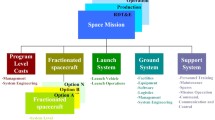Abstract
For the purpose of avoiding interference between each parallel testing tasks in a spacecraft, this paper analyzes the testing process by dividing it into testing atoms, and makes the parameter set as the basic unit for each testing atom resource allocation so as to avoid interference. By means of modeling the parallel testing and with the object of minimizing the total testing time, it puts forward the parallel spacecraft testing task scheduling algorithm on basis of improved particle swarm optimization. The experimental results verify that this method can be efficiently applied in spacecraft parallel testing optimal scheduling.



Similar content being viewed by others
References
Mitchell, T. R. (1973). A standard testing language—GOAL. In 10th workshop on design automation (pp. 87–96).
Garner, J. T. (1996). Satellite control: comprehensive approach. New York: Wiley.
Integral Systems Incorporation (1992). EPOCHT& CSTOL programmer’s reference manual. ISI-EPOCH-0094.
IEEE Standard Coordinating Committee (1996). ATLAS 2000 requirements document revision 2.1. New York: IEEE.
Gil, J., & Holstein, B. (1997). T++: a testing case generator using a debugging information based technique for source code manipulation. In Tools-23: technology of object-oriented languages and systems (p. 272).
ADS2—avionics development system 2nd generation. www.techsat.com/fileadmin/media/pdf/ADS2_ProductOverview/TechSAT_PD_ADS2_CN_1000.pdf.
Ross, W. A. (2003). The impact of next generation testing technology on aviate on maintenance. In 1 AUTOTESTCON proceedings. New York: IEEE.
Anderson, J. L. Jr. (2003). High performance missile testing. In AutotestCon proceedings (pp. 19–27). New York: IEEE.
Karp, R. M. (1972). Reducibility among combinatorial problems. In R. E. Miller & J. W. Thather (Eds.), Complexity of computer computations (pp. 85–103). New York: Plenum.
Lin, G., & Jin, X. (2003). A DNA algorithm for graph node co loringproblem. Acta Electronica Sinica, 31(4), 494–497.
Banerjee, S., Al-Qaheri, H., Chis, M., & Hassan, M. B. A. (2011). An adaptive questionnaire generation using learning from fuzzy and post clustering of customers responses an experience with communication products. Telecommunications Systems, 46(3), 273–284.
Anna, M., Adam, P. B., & Celia, A. G. (2000). Improve graph colouring with linear programming and genetic algorithms. In Proceeding of the 2000 genetic and evolutionary computation conference, Las Vegas, Nevada, USA (pp. 240–245).
Eberhart, R, Kenedy, J (1995). A new optimizer using particles swarm theory. In Proceedings of the sixth international symposium on micro machine and human science, Nagoya, Japan (pp. 39–43): Piscataway: IEEE Service Center.
Zhong, Y.-w., Ning, Z.-y., Cai, R.-y., et al. (2006). An improved discrete particle swarm optimization algorithm. Mini-Micro Systems, 27(10), 1893–1896.
Hulitt, E., & Vaughn, R. B. (2010). Information system security compliance to FISMA standard: a quantitative measure. Telecommunications Systems, 45(2–3), 139–152.
Shi, Y., Eberhart, R.C. (1998). Modified particle swarm optimizer. In Proceedings of the IEEE international conference on evolutionary computation, Piscataway, NJ (pp. 69–73). New York: IEEE Press.
Kennedy, J., & Eberhart, R. C. (1995). Particle swarm optimization. In Proceedings of 1995 IEEE international conference on neural networks, Perth, Australia (pp. 1942–1948).
Kennedy, J. (1998). The behavior of particles. In Proceedings of 7th annual conference on evolutionary programming (pp. 579–589). Berlin: Springer.
Yu, H. (2003). Colored Petri net based modeling of parallel automatic testing systems. Chengdu: School of Automation, University of Electronic Science and Technology of China.
Author information
Authors and Affiliations
Corresponding author
Additional information
The work was supported by Hunan Provincial Natural Science Foundation of China (No. 13JJ6029) and the Program for Excllent Talents in Hunan Normal University (No. ET13108).
Rights and permissions
About this article
Cite this article
Li, Z., Ye, G., Ma, S. et al. The study of spacecraft parallel testing. Telecommun Syst 53, 69–76 (2013). https://doi.org/10.1007/s11235-013-9678-1
Published:
Issue Date:
DOI: https://doi.org/10.1007/s11235-013-9678-1




